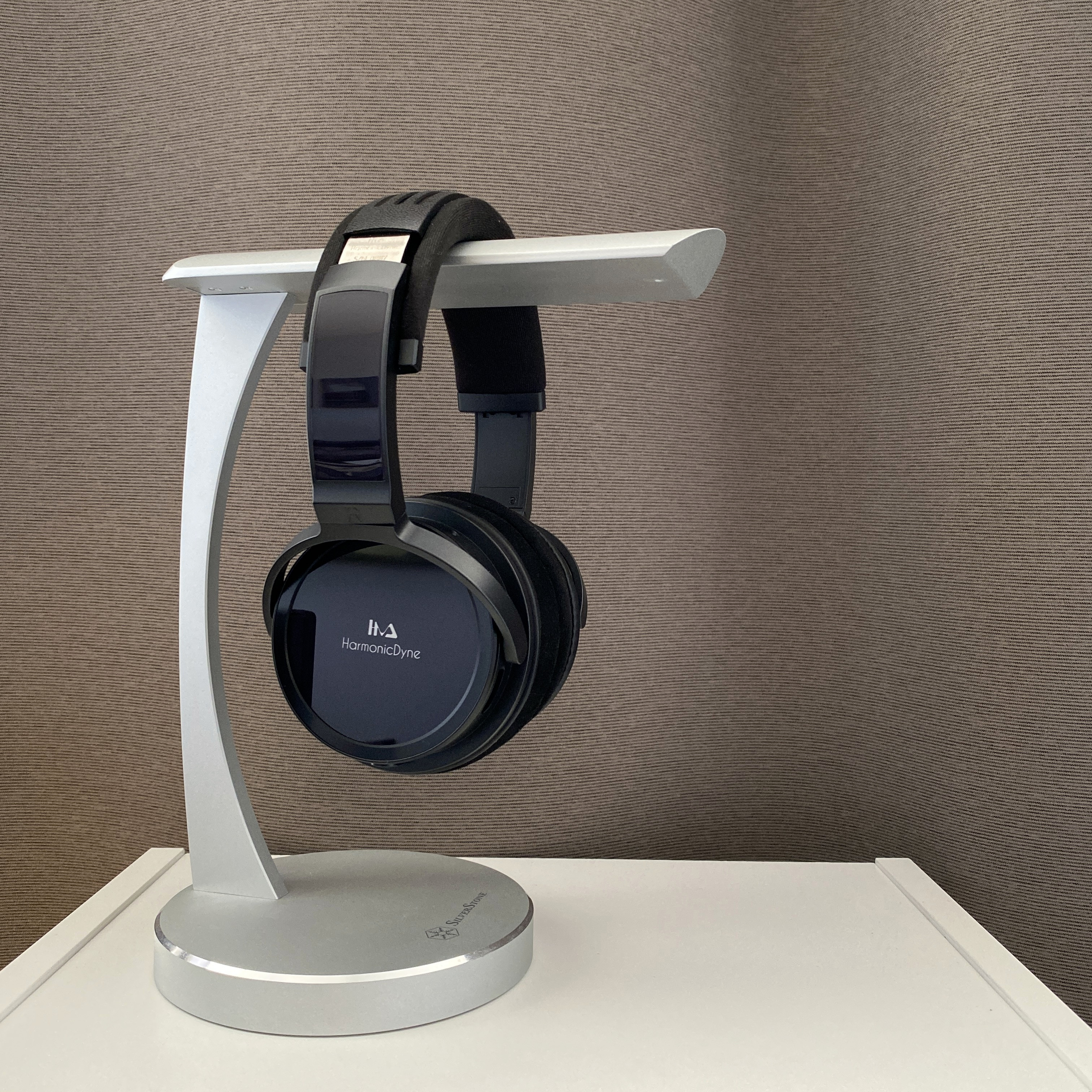
Intro:
Today, I’d like to discuss a recent acquisition of mine – the HarmonidDyne Athena. When I first stumbled upon its product launch details, I was intrigued. The Athena proudly claims to feature a novel driver design with ‘studio-grade tuning’, or at least that’s what the manufacturer’s advertisement suggests. However, upon finally receiving it, my initial enthusiasm quickly dissipated. Let me explain why.
(a small digression: it’s been quite some time since I last wrote a review about a pair of dynamic headphones, so it’s high time I rectify that!)
Foreword:
Firstly, I’d like to talk about how the Athena is marketed. Here’s what the manufacturer’s ad states:
The Athena represents a tonally-balanced sound signature with a 3dB sub-bass boost focused only from 0-200Hz, a flat midrange for a natural sound in instruments and vocals, and an accurate treble that peaks exactly at 3kHz to fit the perceived hearing compensation of the human ear. The Athena is not only our most tonally accomplished headphone, but stands as an accurate and precise tuning standard for future headphones to come in the market.
However, the reality – at least in the context of my specific unit – is quite different from the described attributes. Measurements conducted using the GRAS 43AG reveals a frequency response that drastically diverges from the one depicted in the ad:
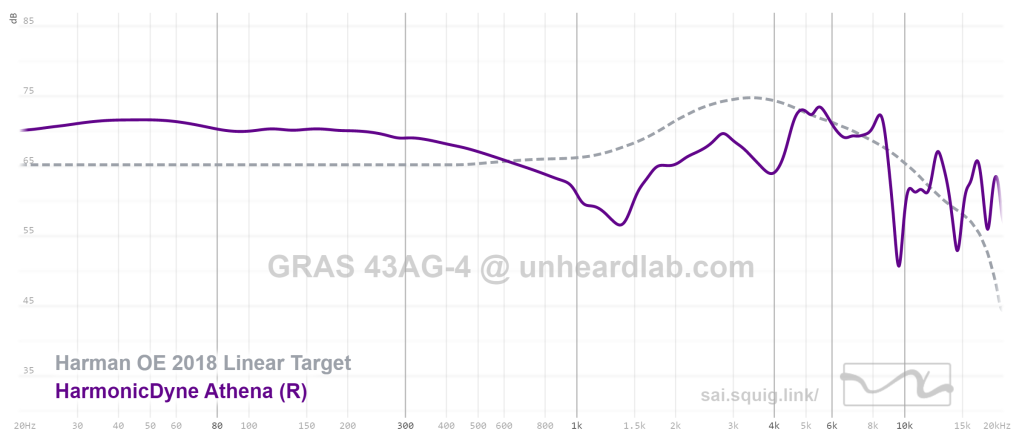

Admittedly, one could argue that the FR curve showcased in the ad is simply a depiction of how HarmonidDyne generally tunes their headphones (in other words, their tuning target), not a specific measurement of the Athena model’s actual FR. I don’t mean to suggest that this is intentionally misleading, but it has the potential to confuse consumers, especially given that the name ‘Athena’ is featured prominently in the centre of the image.
So, I’m not suggesting that HarmonidDyne is neccessarily faking measurements. We are not aware of the specific measurement rig they used or any other conditions that might impact the presentation. Nevertheless, I remain dubious that the FR exhibited derives from any common measurement systems, be it the IEC/ITU-T compliant GRAS systems, B&K systems, or even the miniDSP EARS. If HarmonidDyne is forthcoming with additional context regarding their measurement process, I’ll be more than happy to rectify my comments here.
But there you have it – don’t put too much stock in what the ad says.
Overall impression:
Among the various terms we audiofools to describe sound, perhaps the least applicable in this context are ‘neutral’ or ‘studio reference’ – descriptors that HarmonidDyne essentially used to market the Athena.
On the whole, the Athena presents a notably warm sound profile. It delivers a generous amount of bass, though it can feel congested at times. The mid-range is rich but veiled, lacking the crispness and lucidity one might want. The treble appears a bit uneven and peaks in the consonant range, leading to heightened sibilance in the vocals. The Athena doesn’t particularly excel when it comes to soundstage. While it doesn’t evoke a claustrophobic feeling, it’s certainly not as natural sounding as the HD6XX. Nonetheless, the bass warmth and impact are praiseworthy and perhaps serve as the headphone’s saving grace.
Tonal balance
Bass:
Compared to the unconventional style of the mids, the bass on the Athena is relatively commendable. It’s definitely enhanced and can sound slightly muddy and congested when dealing with bass-heavy tracks, but for music with fewer instruments, such as a ballad or a simple jazz trio, the Athena should perform satisfactorily. The extra bass creates a very warm and relaxed ambience, reminiscent of the Beyerdynamic T1 Gen3 (in fact, the overall sound signature is strikingly similar). I guess that this type of tuning could work quite well for certain genres (i.e., those light on bass), but for most types of music, I find it somewhat overblown, leaning noticeably towards the boomy side and lacking fine texture.
Mids:
The aspect of the tuning I find most disagreeable is the midrange. To put it simply, the mids on the Athena are excessively warm, mellow, and markedly veiled; it’s far removed from what most people would describe as ‘reference’ tuning. Vocals sound as though they’ve been recorded in an acoustically untreated room, laden with reverberations. Meanwhile, there’s a distinct lack of clarity and bite. This produces a peculiar rendition of the vocals where the fundamental tones are rich and full (300-800Hz) while the harmonics are noticeably subdued. Indeed, as you might have guessed, it’s very similar to the presentation found in HarmonidDyne’s earlier products, the Zeus and the Poseidon. However, I found the latter two to be much more balanced overall compared to the Athena.
Of course, it’s entirely plausible that some may find the Athena’s midrange appealing. I do find that some music – generally simpler recordings such as country – sound quite good with the Athena. However, for genres demanding a higher degree of timbre accuracy and an overall sense of naturalness, I wouldn’t recommend the Athena.
Treble:
The treble on the Athena is perhaps… the least problematic area when examined independently. It presents a fair sense of clarity and extension, and one can discern that the driver is competently capable. However, the reality that the upper-mids and lower treble are so subdued results in an uneven transition from mids to treble. This creates an imbalance in tones within this range, accentuating sibilance and the more metallic aspects of the timbre of instruments. It’s generally not grating to listen to, but it doesn’t contribute much in terms of enjoyment either.
If the upper mid-range were more pronounced, the treble presentation on the Athena would be significantly improved overall. Alas, that is not the case here.
Manual sine-sweep:
A manual sine sweep performed on my own head uncovered frequency peaks at 4.5k, 6.5-7k, 8.5k, and 12kHz. The bass level is consistently high. The 9kHz dip did not come across to my ear.
It’s crucial to note that the perception of treble can vary significantly from one person to another, especially above 10kHz. Depending on headphone positioning, your own Head-Related Transfer Function (HRTF), and/or variation in headphone units, you may or may not detect the same peaks or dips.
Other qualities:
- space and stage: The Athena feels somewhat congested, which isn’t surprising for something that falls between a closed-back and a semi-open headphone. It creates the sensation of being enveloped by the instruments, with the vocalist standing directly before you. There isn’t much depth to speak of in the presentation.
- imaging and directionality: This isn’t one of Athena’s strong suits either. Images generally blur together and rarely extend beyond your headspace. Adjusting the angle of the headphones doesn’t result in any notable changes in the sense of directionality.
- clarity: The sense of separation and detail is barely passable, particularly in the bass and mid-range. Once again, it feels as if the music has been recorded in an untreated room. Clarity does improve in the treble range, i.e., the attack of instruments, but the decay is somewhat hazy.
- dynamics and impact: Despite the bass boost, the low end tends to be on the looser and slower side, with drums lacking the desired level of immediacy and punch. It’s not as monotonous or ‘one-note’ as some entry-level planars, although bass nuances can often be overshadowed by the prominent amount of mid-bass. The scale of impact is reasonable, similar to what you might experience on the Zeus.
Conclusion and value:
It should be pretty clear by now that I’m not particularly fond of the Athena. There appears to be an increasing number of headphones now being marketed as having ‘reference’ or ‘studio’ tuning, while the actual sound often diverges dramatically. Every manufacturer seems eager to claim that their tuning faithfully replicates the ‘original sound’, but they might in fact fare better by being honest about their product’s true characteristics, allowing the consumers to choose based on their preferences. HarmonicDyne has, in the past, produced some excellent headphones like the Zeus, which, I believe, satisfied a specific tuning niche whilst maintaining overall technical competence.
Unfortunately, I struggle to see who the Athena is intended for. In terms of tuning, they’re a far cry from what one would typically label as ‘reference tuning’. If people purchase the Athena based on its advertised claims, I’m fairly certain they’ll be disappointed. While some might be intrigued by the specific tuning of the Athena – a somewhat mellow, warm, and enveloping sound with a hint of treble spice – I’m not sure they’ll ever discover the Athena since it isn’t marketed as such.
So, there we have it. With a retail price of $179 USD, the HarmonicDyne Athena is… do I really need to say it outright?
On a brighter note, the Athena is indeed very well-constructed and aesthetically pleasing (in my opinion). There’s a hint of purple visible through the tempered glass back panel, which is elegant to behold. Comfort is also praiseworthy, with the plush velour headband reminiscent of the considerably more premium HD800 in terms of price.
Lastly, if you want to improve the sound, EQ is always an option. Try lowering the mid-bass with a shelf or low-Q filter and cutting back some of the mid-treble should give you with a more ‘orthodox’ sound, if you like.
Pros: ‘esoteric’ tuning that may appeal to a certain market segment; rich and warm sound; decent treble clarity indicating driver capability; less sound leakage than fully open headphones.
Cons: bloated bass that bleeds into the mids; fuzzy and overly mellow midrange distorts vocal timbre; highs are relatively forward due to subdued upper mids; overall technical performance is unimpressive.
MEASUREMENTS
Extended Frequency Response:

note: bass extension cutoff is 10hz instead of 20hz on the extende frequency response measurement, so as to fully capture frequencies which though may not outside of ‘audible range’, may be felt by our ears, bones and muscles and enhance the sense of ‘impact’.
Positional Variation:

note: this graph shows how the tonality might be affected when you wear the headphones differently on the head.
Mod Attempt:
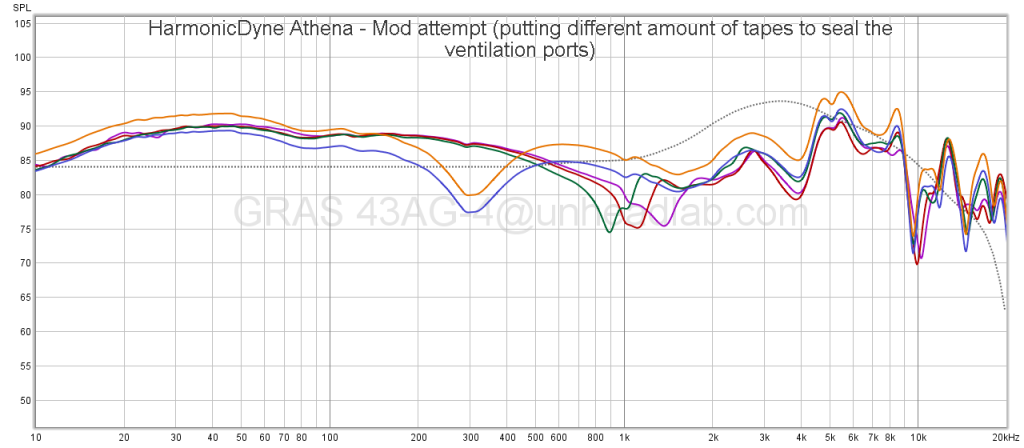
purple=stock, red=1 tape, green=3 tapes, blue&yellow=all taped (volume difference)
Leakage Test:
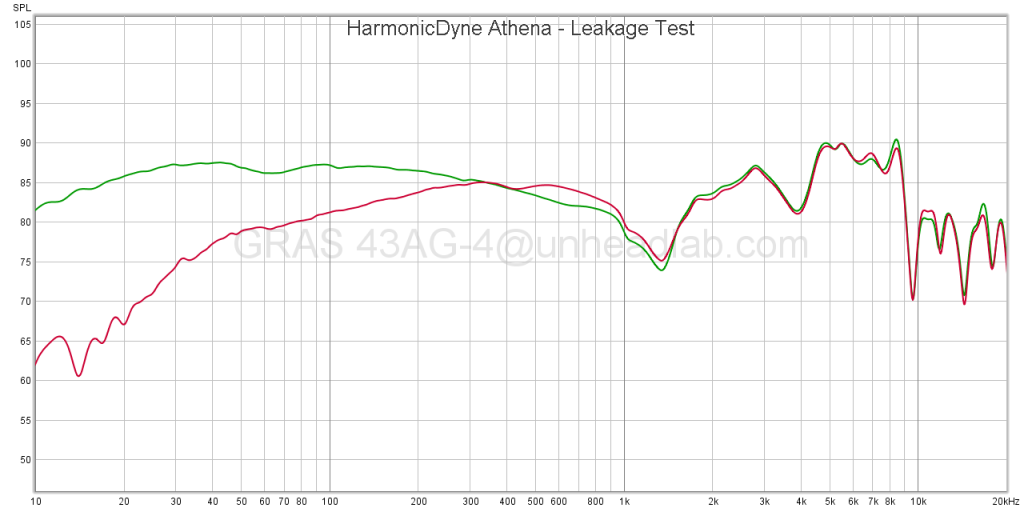
note: this graph demonstrates how a small leakage (simulated using thin-armed glasses) can result in FR change.
Impulse Response:
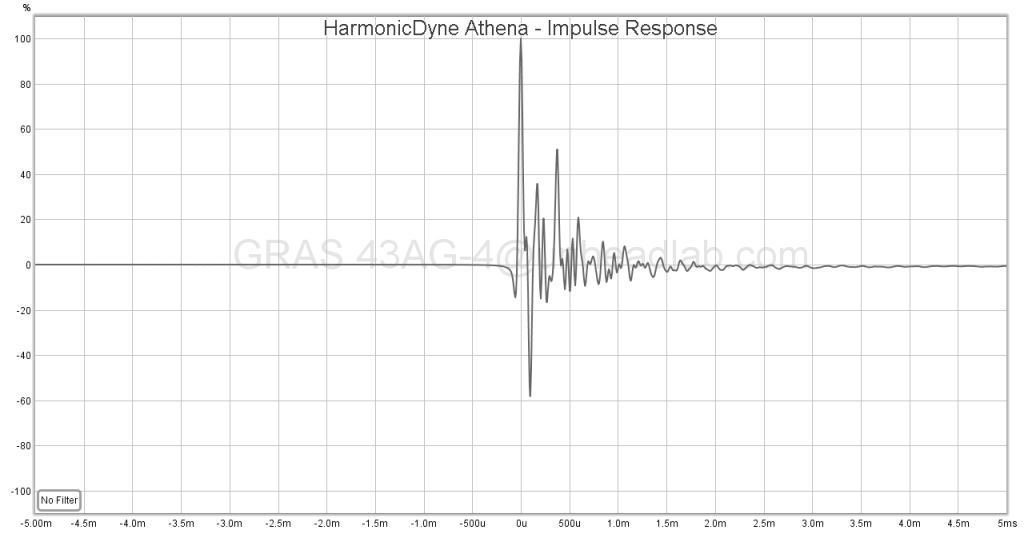
note: impulse response gives time-domain information about the transducer movement after a test tone is played. It should mainly be read for detecting polarity.
Channel Matching:

note: channel matching graphs DOES NOT RELATE TO TONALITY. A specialised configuration is used to capture channel differences to mitigate the interference from positioning on rig, directional sensitivity, and the asymmetricity in GRAS pinnae design (legacy of the Kemar). The Left (blue) and Right (red) channels are measured on a flat plate coupler with IEC60318-4 ear simulator.
END OF ARTICLE
